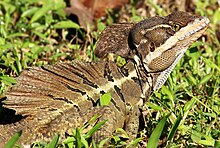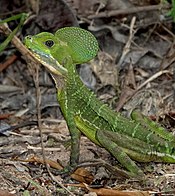| This article includes a list of general references, but it lacks sufficient corresponding inline citations. Please help to improve this article by introducing more precise citations. (March 2024) (Learn how and when to remove this message) |
| Corytophanidae Temporal range: Early Eocene - present, 48–0 Ma PreꞒ Ꞓ O S D C P T J K Pg N | |
|---|---|

| |
| Striped basilisk | |
| Scientific classification | |
| Domain: | Eukaryota |
| Kingdom: | Animalia |
| Phylum: | Chordata |
| Class: | Reptilia |
| Order: | Squamata |
| Suborder: | Iguania |
| Family: | Corytophanidae Fitzinger, 1843 |
| Genera | |
| |
| Synonyms | |
| |
Corytophanidae is a family of iguanian lizards, also called casquehead lizards or helmeted lizards, endemic to the New World. Nine species of casquehead lizards from three genera are recognized.
Geographic range
Corytophanids are found from Mexico, through Central America, and as far south as Ecuador.
Certain species are now extant in South Florida and are considered invasive.
Description
The casquehead lizards are moderately sized lizards, with laterally compressed bodies, and typically have well-developed head crests in the shape of a casque helmet. This crest is a sexually dimorphic characteristic in males of Basiliscus, but is present in both sexes of Corytophanes and Laemanctus. In past years there has been evidence of corytophanids in the Eocene of North America. The greatest percentage of omnivorous species (> 10% plant diet), over 30% in each, and the highest mean percentage of plant matter in the diet are corytophanids.
Behavior
In Corytophanes, the head crests are used in defensive displays, where the lateral aspect of the body is brought about to face a potential predator in an effort to look bigger. Unlike many of their close relatives, they are unable to break off their tails when captured, probably because the tail is essential as a counterbalance during rapid movement.
Habitat
Casquehead lizards are forest-dwelling. All corytophanids are excellent climbers, and they are usually found in trees or low bushes.
Reproduction
Despite the small number of species in the family Corytophanidae, it includes both egg-laying species and species that give birth to live young.
Genera and species
Family Corytophanidae
| Image | Genus | Living species |
|---|---|---|

|
Basiliscus Laurenti, 1768 |
|

|
Corytophanes H. Boie in Schlegel, 1826 |
|

|
Laemanctus Wiegmann, 1834 |
|
Nota bene: In the following lists, a binomial authority in parentheses indicates that the species was originally described in a different genus.
References
- ^ Frost DR, Etheridge R (1989). "A Phylogenetic Analysis and Taxonomy of Iguanian Lizards (Reptilia: Squamata)". Univ. Kansas Mus. Nat. Hist., Misc. Pub. (81): 1-65. ("Corytophanidae Fitzinger, 1843", p. 34.)
- "Corytophanidae".
- "Corytophanidae". Dahms Tierleben. www.dahmstierleben.de/systematik/Reptilien/Squamata/Iguania/corytophanidae.
- ^ Bauer, Aaron M. (1998). Cogger, H.G.; Zweifel, R.G. (eds.). Encyclopedia of Reptiles and Amphibians. San Diego: Academic Press. pp. 134–136. ISBN 0-12-178560-2.
- ^ Pough et al. (2003).
- Cooper Jr, W., & Vitt, L. (2002). Distribution, extent, and evolution of plant consumption by lizards. Journal of Zoology, 257(4), 487-517. doi:10.1017/S0952836902001085
- Leenders, Twan (2019-08-15), "Family Corytophanidae", Reptiles of Costa Rica, Cornell University Press, pp. 135–146, doi:10.7591/9781501739545-022, ISBN 978-1-5017-3954-5, retrieved 2024-03-24
- Family Corytophanidae. The Reptile Database. www.reptile-database.org.
Further reading
- Fitzinger L (1843). Systema Reptilium, Fasciculus Primus, Amblyglossae. Vienna: Braumüller & Seidel. 106 pp. + indices. (Family Corythophanae, p. 52). (in Latin).
- Pough FH, Andrews RM, Cadle JE, Crump ML, Savitsky AH, Wells KD (2003). Herpetology, Third Edition. Upper Saddle River, New Jersey: Pearson Education, Inc. 736 pp. ISBN 978-0131008496. (Corytophanidae, p. 129).
| Squamata families | |||||||
|---|---|---|---|---|---|---|---|
| Dibamia | |||||||
| Gekkota | |||||||
| Scincoidea | |||||||
| Laterata / Lacertoidea |
| ||||||
| Anguimorpha | |||||||
| Iguania | |||||||
| Serpentes |
| ||||||
| Taxon identifiers | |
|---|---|
| Corytophanidae | |